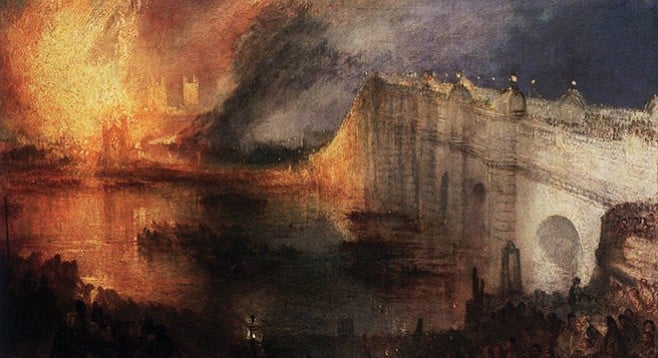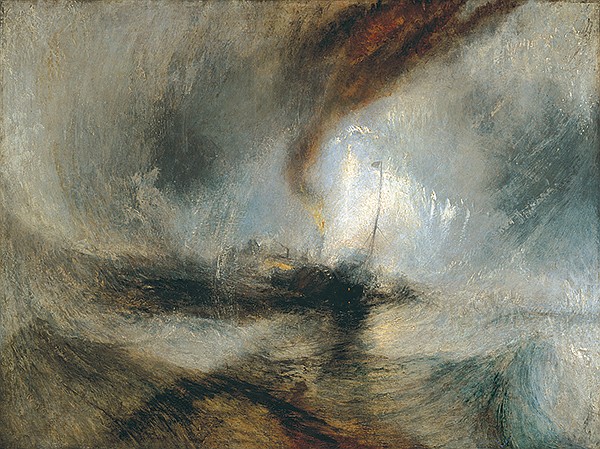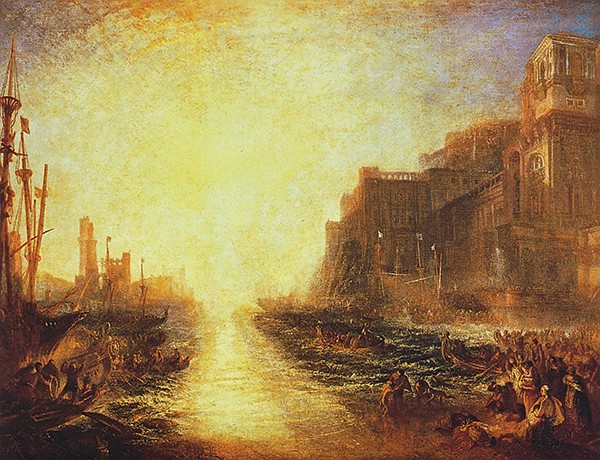 Facebook
Facebook
 X
X
 Instagram
Instagram
 TikTok
TikTok
 Youtube
Youtube

Painters in mid-19th-century London, when installing exhibitions at official venues such as the Royal Academy of Art and the British Institution, brought not-quite-finished pictures to what were called Varnishing Days, where they discussed each other’s work and applied a finish to their pictures. J.M.W. Turner, especially in his later years, pushed the purpose of Varnishing Days to the extreme. He often brought work still in the early stages of completion then elaborated details, shaping narrative content and working up his most signature splashy effects. Turner never lacked a sense of self-drama, and these flamboyant displays, part mischief but mostly the natural consequence of the nervous energy he poured into his work, became notorious events. By age 60, though esteemed and well off, he was more than ever an object of contempt by journalists and connoisseurs. It looked as if the excitableness that had characterized his pictures for so long was becoming his real subject. The contested, explosive work of his late years, from the 1830s to his death in 1851, is the subject of J.M.W. Turner: Painting Set Free, currently at the Getty Center.
Joseph Mallord William Turner was born in London in 1775. His father, a barber and wig-maker, recognized his son’s gifts early and by age 14 Turner was attending the Royal Academy, where he would later teach. He was an ambitious young artist determined to establish a major reputation. Landscapes, great houses, marine pictures, treatments of historical subjects and contemporary events — Turner wanted it all. Around 1818 he’d made a series of paintings about the rise and fall of ancient Carthage and a grim picture of the carnage on the battlefield of Waterloo. He was also a documentarian of industrialized modernity, especially its steamships and railways. He expressed the newness of the age with an incendiary stylistic newness.
In the 1830s Turner’s work became looser, more diffuse and volatilized, and his critics became more rabid, comparing his work to soapsuds, whitewash, mustard. One caricaturist depicted him at his easel wielding a mop, with a pail of yellow paint at his feet. It was obvious by the 1830s that every picture was in some way an occasion for challenging his materials. The execution was loaded with emotion: Turner painted his feeling for depicted events by generating fierce atmospherics created to surround or emanate from such events. You recognize a late Turner before recognizing its anecdotal content. Blizzards, rainstorms, biblical winds — any prodigious force of nature brought forth a response that, in the language of the canvas, aspired to meet force with force. The radiance in the pictures seems almost hysterical and the restless darkness as unforgiving and devouring as any painter has given us.
Consider one of his best-known paintings, The Burning of the Houses of Lords and Commons, 16 October, 1834. The fire started at night and drew a large crowd, Turner among them. It was exhibited at the British Institution, and another artist said that Turner brought to Varnishing Days a canvas that had just barely a primary lay-in of color and did the pyrotechnical detail work there. He created a contagion of combustion: Westminster Bridge seems to catch fire and melt into the flames that whip from the Houses. It’s an of-the-moment event, but, like other Turner pictures, folds into contemporary event something anachronistic or “other.” While The Burning swarms with the torchlight the fire creates, in the dark foreground a group of women talks to someone dressed in medieval clerical garb. These “outsiders” have their backs to the fire, as if watching the watchers, a ceremonial past observing a contemporary chaos.

The steamship, introduced in the 1810s, transformed the shipping industries, and by the 1830s it was one of Turner’s subjects, but the mechanization steamships represented didn’t distract him from the sublime, which became the cosmic envelope that raveled up technology. He came of age when the Romantic poets were at their peak powers. Keats died in 1831, Shelley, 1822, Wordsworth, 1850, and Turner was as concerned with the nature of nature as the poets were. (He was also literary and left behind an unfinished historical epic, Fallacies of Hope.) His earlier paintings often had a histrionic grandeur, but from the 1830s on, nature became an even more agitated roughhouse theater of impartial and indifferent force, of cones and gyres and spikes of light and rain and darkness. His 1842 Snow Storm makes me think of mad Lear on the heath: “Blow, winds, and crack your cheeks! rage! blow! You cataracts and hurricanoes.” We see a steamboat trapped and tossed in a whirlwind, its hull indistinguishable from the rotund up-swelling of the sea: grand circulatory vortexes of grays, blacks, and browns scoop up and around the vessel while it shoots off phosphorescent signaling rockets.

When treating historical or classical subjects, Turner liked to shrink anecdotal content, as if to check the relative scale of human event against nature’s process. He deposits the action of Regulus (about a self-sacrificing Roman general who turns himself over to his Carthaginian enemies: they imprison him then cut off his eyelids and expose him to the sun) in the picture’s lower left pocket, a vague concentrate of action. What overwhelms the viewer is a sulfurous hourglass of yellow-white light that spools down through the picture. You feel Turner aspiring to a pictorial language equivalent to the expressive energies nature possessed. His most sensuous effects are often the most vaporous. His contemporary Constable said his pictures were “painted with tinted steam.”
To his students, Turner’s advice about watercolors was: “First of all, respect your paper!” He made watercolors wet on wet, putting color into not-yet-dry color, and he used already wet paper sometimes treated with animal glue, which made the paper less absorbent. The colors, for all the speediness of application, sometimes have a congealed, mounded profile, as if gathered into form. His watercolors of Venice in particular possess (and induce) the astonishment of his oil paintings, but the medium gives them more quivery dynamics, apt for a city so heavily inflected by the lagoon that contains it. In Fishermen on the Lagoon, moonlight whitens the sky then shafts down through the water’s surface and breaks up to create an under-bed of luminosity. The fishermen on their platform and boats are fragile materializations of darkness within the enveloping nocturnal light.
There’s an extreme yet celebratory urgency in many of Turner’s pictures, and a visionary purpose. He folds into an of-the-instant natural event both its fore-moment and premonitions of its after-moment. He was a poet of colossal circumstantiality. His surfaces’ fabulous, uneven topographies document his spontaneous process and emotional intensity. In any marine painting you’re likely to find a jet or surge of surf rendered as an archipelago of lumps and blots of pigment, and the streaky layering can look like yellowing scar tissue, beautiful scar tissue: it’s as if he’s in a compulsive rush to register one effect so that he can chase yet another.
Turner’s pictures of the whaling industry are among the most exciting things in Painting Set Free. He creates a busy field of contesting teeming masses, of sun and sea beating against the whalers’ activities — the harpooning, the hoisting of a whale’s head, the rendering of blubber. But the exhibition also provides a lot of evidence for Turner’s control over a variety of emotional tones. When the familiar incandescent energy gets sober and subdued, you feel a turbulent world has been momentarily becalmed. In pastoral pictures from his several Italian excursions, when a tree appears it becomes a strong axial compass for the stirring airs surrounding it. The tree looks steadfast and enduring.
J.M.W. Turner: Painting Set Free, on view at the Getty Center in Los Angeles until May 24. 1200 Getty Center Drive, 310-440-7300, getty.edu


Painters in mid-19th-century London, when installing exhibitions at official venues such as the Royal Academy of Art and the British Institution, brought not-quite-finished pictures to what were called Varnishing Days, where they discussed each other’s work and applied a finish to their pictures. J.M.W. Turner, especially in his later years, pushed the purpose of Varnishing Days to the extreme. He often brought work still in the early stages of completion then elaborated details, shaping narrative content and working up his most signature splashy effects. Turner never lacked a sense of self-drama, and these flamboyant displays, part mischief but mostly the natural consequence of the nervous energy he poured into his work, became notorious events. By age 60, though esteemed and well off, he was more than ever an object of contempt by journalists and connoisseurs. It looked as if the excitableness that had characterized his pictures for so long was becoming his real subject. The contested, explosive work of his late years, from the 1830s to his death in 1851, is the subject of J.M.W. Turner: Painting Set Free, currently at the Getty Center.
Joseph Mallord William Turner was born in London in 1775. His father, a barber and wig-maker, recognized his son’s gifts early and by age 14 Turner was attending the Royal Academy, where he would later teach. He was an ambitious young artist determined to establish a major reputation. Landscapes, great houses, marine pictures, treatments of historical subjects and contemporary events — Turner wanted it all. Around 1818 he’d made a series of paintings about the rise and fall of ancient Carthage and a grim picture of the carnage on the battlefield of Waterloo. He was also a documentarian of industrialized modernity, especially its steamships and railways. He expressed the newness of the age with an incendiary stylistic newness.
In the 1830s Turner’s work became looser, more diffuse and volatilized, and his critics became more rabid, comparing his work to soapsuds, whitewash, mustard. One caricaturist depicted him at his easel wielding a mop, with a pail of yellow paint at his feet. It was obvious by the 1830s that every picture was in some way an occasion for challenging his materials. The execution was loaded with emotion: Turner painted his feeling for depicted events by generating fierce atmospherics created to surround or emanate from such events. You recognize a late Turner before recognizing its anecdotal content. Blizzards, rainstorms, biblical winds — any prodigious force of nature brought forth a response that, in the language of the canvas, aspired to meet force with force. The radiance in the pictures seems almost hysterical and the restless darkness as unforgiving and devouring as any painter has given us.
Consider one of his best-known paintings, The Burning of the Houses of Lords and Commons, 16 October, 1834. The fire started at night and drew a large crowd, Turner among them. It was exhibited at the British Institution, and another artist said that Turner brought to Varnishing Days a canvas that had just barely a primary lay-in of color and did the pyrotechnical detail work there. He created a contagion of combustion: Westminster Bridge seems to catch fire and melt into the flames that whip from the Houses. It’s an of-the-moment event, but, like other Turner pictures, folds into contemporary event something anachronistic or “other.” While The Burning swarms with the torchlight the fire creates, in the dark foreground a group of women talks to someone dressed in medieval clerical garb. These “outsiders” have their backs to the fire, as if watching the watchers, a ceremonial past observing a contemporary chaos.

The steamship, introduced in the 1810s, transformed the shipping industries, and by the 1830s it was one of Turner’s subjects, but the mechanization steamships represented didn’t distract him from the sublime, which became the cosmic envelope that raveled up technology. He came of age when the Romantic poets were at their peak powers. Keats died in 1831, Shelley, 1822, Wordsworth, 1850, and Turner was as concerned with the nature of nature as the poets were. (He was also literary and left behind an unfinished historical epic, Fallacies of Hope.) His earlier paintings often had a histrionic grandeur, but from the 1830s on, nature became an even more agitated roughhouse theater of impartial and indifferent force, of cones and gyres and spikes of light and rain and darkness. His 1842 Snow Storm makes me think of mad Lear on the heath: “Blow, winds, and crack your cheeks! rage! blow! You cataracts and hurricanoes.” We see a steamboat trapped and tossed in a whirlwind, its hull indistinguishable from the rotund up-swelling of the sea: grand circulatory vortexes of grays, blacks, and browns scoop up and around the vessel while it shoots off phosphorescent signaling rockets.

When treating historical or classical subjects, Turner liked to shrink anecdotal content, as if to check the relative scale of human event against nature’s process. He deposits the action of Regulus (about a self-sacrificing Roman general who turns himself over to his Carthaginian enemies: they imprison him then cut off his eyelids and expose him to the sun) in the picture’s lower left pocket, a vague concentrate of action. What overwhelms the viewer is a sulfurous hourglass of yellow-white light that spools down through the picture. You feel Turner aspiring to a pictorial language equivalent to the expressive energies nature possessed. His most sensuous effects are often the most vaporous. His contemporary Constable said his pictures were “painted with tinted steam.”
To his students, Turner’s advice about watercolors was: “First of all, respect your paper!” He made watercolors wet on wet, putting color into not-yet-dry color, and he used already wet paper sometimes treated with animal glue, which made the paper less absorbent. The colors, for all the speediness of application, sometimes have a congealed, mounded profile, as if gathered into form. His watercolors of Venice in particular possess (and induce) the astonishment of his oil paintings, but the medium gives them more quivery dynamics, apt for a city so heavily inflected by the lagoon that contains it. In Fishermen on the Lagoon, moonlight whitens the sky then shafts down through the water’s surface and breaks up to create an under-bed of luminosity. The fishermen on their platform and boats are fragile materializations of darkness within the enveloping nocturnal light.
There’s an extreme yet celebratory urgency in many of Turner’s pictures, and a visionary purpose. He folds into an of-the-instant natural event both its fore-moment and premonitions of its after-moment. He was a poet of colossal circumstantiality. His surfaces’ fabulous, uneven topographies document his spontaneous process and emotional intensity. In any marine painting you’re likely to find a jet or surge of surf rendered as an archipelago of lumps and blots of pigment, and the streaky layering can look like yellowing scar tissue, beautiful scar tissue: it’s as if he’s in a compulsive rush to register one effect so that he can chase yet another.
Turner’s pictures of the whaling industry are among the most exciting things in Painting Set Free. He creates a busy field of contesting teeming masses, of sun and sea beating against the whalers’ activities — the harpooning, the hoisting of a whale’s head, the rendering of blubber. But the exhibition also provides a lot of evidence for Turner’s control over a variety of emotional tones. When the familiar incandescent energy gets sober and subdued, you feel a turbulent world has been momentarily becalmed. In pastoral pictures from his several Italian excursions, when a tree appears it becomes a strong axial compass for the stirring airs surrounding it. The tree looks steadfast and enduring.
J.M.W. Turner: Painting Set Free, on view at the Getty Center in Los Angeles until May 24. 1200 Getty Center Drive, 310-440-7300, getty.edu
Comments